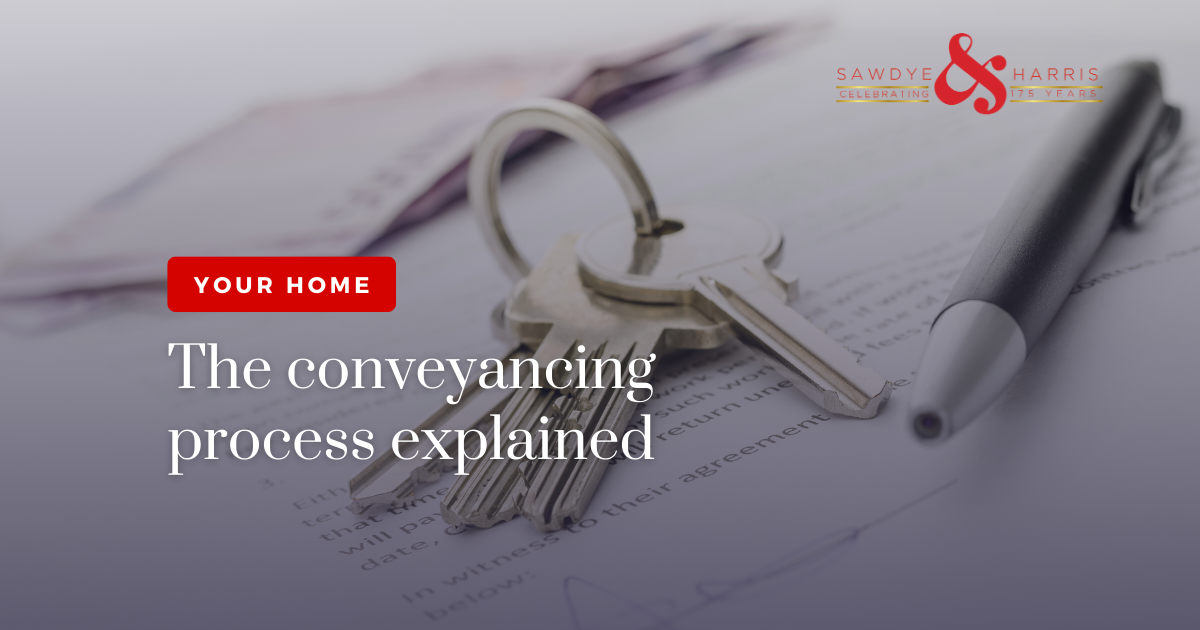The conveyancing process explained
What is conveyancing? It's the legal process of transferring the ownership of property from the seller to the buyer. We explain everything you need to know about the stages of the conveyancing process when buying.
What is conveyancing?
Conveyancing is the legal transfer of home ownership from the seller to you, the buyer. The conveyancing process starts when your offer on a house is accepted and finishes when you have completed the purchase and receive the keys. It’s a service you’ll be paying a good few hundred pounds for and a critical part of buying your home – so you’ll want to get it right.
Who does the conveyancing?
When you’re buying a home, a solicitor or conveyancer usually conducts the conveyancing process, but it is possible (although difficult) to do it yourself as long as you are not taking out a mortgage.
The stages of the conveyancing process
There are a number of stages of the conveyancing process. Here’s our step by step guide to the conveyancing process for buyers.
Stage 1: Instruct a conveyancing solicitor
The first stage of the conveyancing process is to find the right solicitor or conveyancer and instruct them to start work on the legal side of your purchase.
If you’re considering using the conveyancing solicitor recommended by the estate agent for the house you’re buying, we’d advise you to compare conveyancing quotes first to check you’re getting a good deal. You’re not obliged to use the conveyancer the estate agent recommends and you may get a better service for a better price by shopping around. We can help with a conveyancing quote – just click here
Once you’ve got a few conveyancing quotes from different firms, give them a ring to discuss how they work. Once you’ve instructed a conveyancing solicitor, they will undertake the relevant ID and Anti-Money Laundering checks. And they’ll write to your sellers solicitor to confirm they are instructed and request a copy of the draft contract and any other details, such as the property’s title and the standard forms.
Stage 2: Draft contract and raising enquiries
One of the first stages of the conveyancing process involves your solicitor examining the draft contract and supporting documents and raising enquiries with the seller’s solicitor. You will be expected to go through the paperwork and forms the seller has completed, including the TA6 form and let the solicitor know if you have any queries or concerns.
In particular, you will want to double check the tenure of your new home: is it freehold or leasehold ? If you’re buyig a leasehold do check the length of the lease. This is a critical piece of information. Leases below 80 years can be a problem, can be costly to extend and you need to have owned the property for 2 years before you are eligible to do so. Leases under 60 years are best avoided.
When you’re buying a home, you’ll want the process to be as smooth as possible so make sure you respond promptly to queries and also ask for regular updates from your conveyancer and estate agent.
Stage 3: Arranging a property survey
While it’s not a legal requirement, it’s a good idea to have a survey conducted. The survey report will highlight any major problems and may recommend extra investigations. The sort of survey you have done will depend on your specific circumstances. Depending on the results of the survey, you may want to go ahead with the purchase, renegotiate the price or even decide to pull out. So it’s a good idea to arrange your house survey as early as possible.
Once you’ve had a survey done, your conveyancing solicitor can advise on what to do next. Whether there are problems you want fixed before purchase or issues you want to investigate further, they can liaise with the sellers solicitor. If there are significant issues flagged up by the survey, you may want to renegotiate the price and your conveyancing solicitor will need to be looped in to get everything agreed in writing.
Stage 4: Conducting property searches
There are things you may not know about the property just from viewing it with estate agents or even from a survey. As part of the house conveyancing process, a conveyancing solicitor will carry out a set of legal property searches to ensure there are no other factors you should be aware of. Some searches will be recommended by the solicitor for all purchases and others will be required by the mortgage lender to protect them from any liabilities that the property may have.
These property searches include:
- Local Authority searches: Are there plans for a motorway at the end of your new garden? How about radioactive gas?
- Checking the ‘title register’ and ‘title plan’ at the Land Registry – these are the legal documents proving the seller’s ownership. Both checks are legally required in order to sell
- Checking flood risk – this can also done at the Land Registry. If you are already getting an environmental search (see below), you might not buy this one separately as the search will contain much more thorough flood information and maps
- Water authority searches – find out how you get your water and if any public drains on the property might affect extensions or building works
- Chancel repair search – to ensure there are no potential leftover medieval liabilities on the property to help pay for church repairs. However, you may decide to take out Chancel repair insurance instead for £20 or so. The laws around Chancel repair changed in October 2013 so now the onus is on the Church to establish and lodge liability with the Land Registry
- Environmental Search – this report is used on the vast majority of transactions and is provided by either Landmark or Groundsure. Depending which product your solicitor usually uses, the report will give information about contaminated land at or around the property, landfill sites, former and current industry, detailed flooding predictions, radon gas hazard, ground stability issues, and some other related information
- Optional and location specific searches – sometimes extra searches are required or recommended depending on the location or type of property or due to particular concerns raised by the buyer. These could include:
- Tin Mining searches in Cornwall
- Mining searches in various parts of the UK and Cheshire Brine searches
- Additional Local Authority Questions such as Public Paths, Pipelines, Noise Abatement Zones, Common Land, etc
The cost of these property searches are often charged as extras, so make sure you factor them in to the conveyancing fees.
Stage 5: Conveyancing for your mortgage
You will need to get your mortgage in place, which includes ensuring you have the financing available for a mortgage deposit.
As part of the process of getting a mortgage, you’ll need to get a mortgage valuation. This is carried out on behalf of the mortgage company so they know that the property you’re buying provides sufficient security for the loan. You normally have to pay for it, but a mortgage company might throw it in for free to attract business. But don’t let a free valuation sway you, it’s vital you pick the best mortgage for you.
Stage 6: Arrange buildings insurance
If you need a mortgage to buy the property, your lender will require you to get buildings insurance for your new home before exchange of contracts can take place. That’s because you are responsible for the property as soon as contracts have been exchanged. So shop around before you exchange to find the best policy at the best price.
Stage 7: Signing contracts
Since receiving the draft contract from the seller’s solicitor at the start of the house conveyancing process, your solicitor will have been in correspondence with you about what is covered. Before signing the contract your solicitor will need to ensure:
- That all enquiries have been returned and are satisfactory.
- That fixtures and fittings included in the purchase are what you expected.
- A completion date has been agreed between parties, which can be simultaneous with exchange or might be a few days or weeks after exchange of contracts, although this can vary widely and depends on all parties involved in the transaction.
- That you have made arrangements to transfer the deposit into your solicitor’s account so that it is cleared in time for an exchange. You may want to negotiate on the size of the deposit, which is normally 10% of the value of the property. However, even if you agree to pay less than 10%, you are still liable for 10% of the value of the property if you later pull out of the agreement. Therefore, if you pay a 5% deposit and pull out of buying the property, you will not only lose your deposit but also legally owe an additional 5% of the value of the property.
It’s a good idea to go to the property with the estate agent and the fixtures and fittings inventory list to ensure that everything you paid for is still there and the house has not been damaged in any way.
Stage 8: Exchanging contracts
Exchanging contracts is one of the most important stages of the conveyancing process. You and the seller will agree on a date and time to exchange contracts. Your solicitor will exchange contracts for you, which is usually done by both conveyancing solicitors reading out the contracts over the phone (which is recorded) to make sure the contracts are identical, and then immediately sending them to one another in the post.
If you are in a housing chain your solicitor/conveyancer will do the same thing, but will only release it if the other people in the chain are all happy to go ahead. This means if one person pulls out or delays, then everyone in the chain gets held up.
Once you have exchanged contracts you will be in a legally binding contract to buy the property with a fixed date for moving. This means that:
- If you do not complete the purchase, you will lose your deposit and owe the seller more if the deposit was less than 10%
- The seller has to sell or you can sue them
- The seller can no longer accept another offer (you no longer need to worry about being gazumped)
Stage 9: Between exchange and completion
You’re now in the final stages of the house conveyancing process. The period between exchange and completion involves your solicitor lodging an interest in the property, which will mean that the deeds to the property are frozen for 30 working days to allow your solicitor to process payment to the seller and lodge your application to the Land Registry to transfer the deeds into your name.
The seller will move out (although they may leave this to the day of completion).
You should get organised for your moving day and organise your removals and broadband for your new home to ensure it’s set up on time for your moving-in day.
Your solicitor will send you a statement showing the final figure to pay, which will need to be cleared into your solicitors bank account at least one day before completion. Your solicitor will apply to your mortgage lender for the mortgage loan.
Stage 10: Completion day
Completion is normally set around midday on the specified date, although in practice takes place when the seller’s solicitor confirms that they have received all the money that is due. Once this happens, the seller should drop the keys at the estate agent for your collection. This means that the house conveyancing process is over, and you can move in.
Stage 11: What happens after completion?
After completion, your solicitor will tie up the last few stages of the house conveyancing process:
- Pay Stamp Duty Land Tax on your behalf.
- Your conveyancer will register the property in your name at the Land Registry. It can take anywhere from two to six months to register a property and may take significantly longer depending on your circumstances.
- Notify the freeholder if the property is leasehold
- Give you a bill for their payment
You will want to collect together all your paperwork from the purchase of your new home, including the estate agent’s brochure, to file away and keep safe for when you might want to move again.
Stages of the conveyancing process timeline
The conveyancing process starts when you make an offer on a property – or accept an offer on your home – and lasts until completion day when keys for the property are exchanged. The conveyancing process may be shorter if you are a cash buyer.
The conveyancing process usually takes around 12-16 weeks.
|
CONVEYANCING PROCESS STEP |
APPROX TIME |
|
Pre contract work: appoint conveyancer, instruct local searches, get survey, get draft contract |
2 weeks |
|
Time to arrange mortgage |
4 weeks |
|
Draft contract: reviewing survey report, local searches, answering outstanding questions |
2-10 weeks |
|
Time between exchange and completion |
1 week |
|
Total time from an offer being accepted to completion |
12-16 weeks |
Is conveyancing different for leaseholds?
Yes. If you’re buying a leasehold flat or house, there are additional steps to the process. It will usually take longer because:
- The seller will need to provide a leasehold management pack and these can take several weeks to arrange.
- Your conveyancer will also need to review the lease in order to advise you on any conditions or obligations it contains that may impact on your decision to proceed. This may result in the need to raise further enquiries.
The conveyancing process for sellers
If you’re selling a house you’ll also want to know about the conveyancing process when selling. There are some stages of the conveyancing process for buyers that won’t apply to you. For example, you won’t need to apply for property searches. But there are some extra stages of the conveyancing process you’ll need to undertake, for example, you’ll be asked to complete a TA6 form and other forms, as well as collect together a number of documents required when selling.
Credit: Edited from an article produced by www.hoa.org.uk





